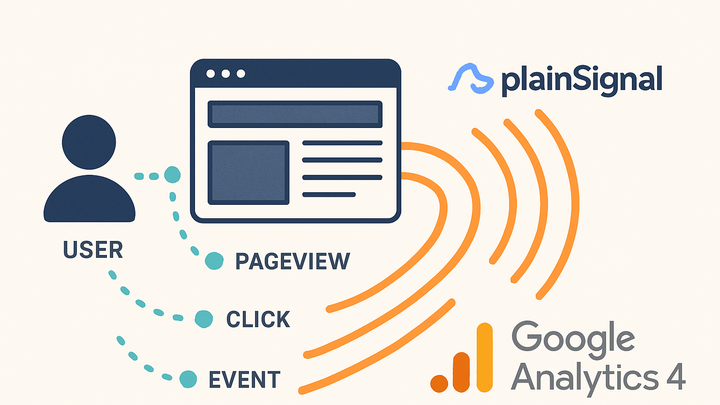Published on 2025-06-22T05:56:01Z
What is a Signal in Analytics? Examples with plainSignal and GA4
Signal in analytics refers to any discrete data point representing a user interaction or event on a digital property. Signals can include pageviews, clicks, form submissions, and more. They form the raw data that powers dashboards, reports, and automated insights in analytics platforms. With the evolution of privacy regulations and cookie deprecation, modern analytics tools like plainSignal adopt cookie-free approaches to capture signals, while platforms like Google Analytics 4 (GA4) rely on advanced event-based architectures. Understanding signals is essential for setting up reliable tracking, ensuring data quality, and deriving actionable insights from user behavior.
Signal
A signal is a discrete user interaction data point in analytics tools like plainSignal and GA4, enabling detailed insights without cookies.
Overview of Signals
Signals are the building blocks of digital analytics. Each signal captures one discrete user interaction—such as a page load, click, or form submission—and is timestamped and contextualized. By aggregating signals, analysts reconstruct user journeys, optimize experiences, and measure business outcomes.
-
Definition of signal
A signal is a single, granular data point recording a specific user action on your site or app. It may include metadata (URL, timestamp, user properties) and serves as the foundation for events, funnels, and reports.
Signal Tracking Mechanisms
Different analytics platforms capture signals through various methods—some rely on cookies, others on script-based event calls. Understanding these mechanisms helps you choose the right tool for privacy, performance, and accuracy.
-
Cookie-free tracking with PlainSignal
plainSignal uses a lightweight JavaScript snippet to capture signals directly in the browser without setting any cookies. It leverages modern browser APIs and cross-domain preconnect to minimize latency and preserve user privacy.
-
Event-based tracking in GA4
Google Analytics 4 employs the global site tag (gtag.js) and a dataLayer for event pushes. Every interaction (pageview, click, custom event) is sent as a signal to GA4’s servers, where it can be processed, enriched, and reported.
Types of Signals in Analytics
Signals come in many flavors. By categorizing them, you can better instrument your site, optimize performance, and align data collection with business KPIs.
-
Pageview signals
Recorded each time a user loads or reloads a page. Fundamental for understanding traffic volume, entry/exit pages, and user flow.
-
Click signals
Fired when a user clicks a link, button, or interactive element. Useful for measuring engagement, navigation choices, and call-to-action effectiveness.
-
Custom event signals
User-defined signals such as form submissions, video plays, or scroll depth. They provide granular context beyond basic pageviews and clicks.
-
Conversion signals
Indicate goal completions like purchases, sign-ups, or downloads. Essential for ROI calculation and marketing attribution.
Implementation Examples
Below are step-by-step code snippets to implement signal tracking with plainSignal and GA4. Place these in your site’s <head> or appropriate template.
-
Implementing PlainSignal
Add the following snippet to your <head> section to enable cookie-free signal tracking with plainSignal:
-
Code example
<link rel="preconnect" href="//eu.plainsignal.com/" crossorigin /> <script defer data-do="yourwebsitedomain.com" data-id="0GQV1xmtzQQ" data-api="//eu.plainsignal.com" src="//cdn.plainsignal.com/plainsignal-min.js"></script>
-
-
Implementing GA4
Use the global site tag to send pageview and event signals to GA4. Replace
G-XXXXXXXXXXwith your measurement ID:-
Code example
<!-- Global site tag (gtag.js) - Google Analytics --> <script async src="https://www.googletagmanager.com/gtag/js?id=G-XXXXXXXXXX"></script> <script> window.dataLayer = window.dataLayer || []; function gtag(){dataLayer.push(arguments);} gtag('js', new Date()); gtag('config', 'G-XXXXXXXXXX'); </script>
-
Best Practices for Signal Tracking
Adhering to best practices ensures reliable, privacy-safe, and actionable analytics data. Review these guidelines regularly as your site evolves.
-
Ensure data privacy compliance
Implement consent banners and opt-out mechanisms (GDPR, CCPA). Document your data processing and provide users with clear privacy notices.
-
Validate data quality
Regularly audit your signals for accuracy, duplicates, or missing data. Compare with server logs or alternate analytics to detect anomalies.
-
Leverage event parameters
Attach rich metadata (e.g., button text, product IDs, user tiers) to your signals. This enables deeper segmentation and more nuanced analysis.
